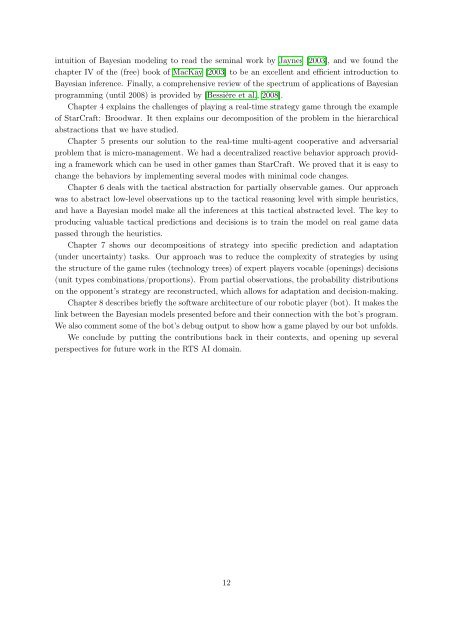Bayesian Programming and Learning for Multi-Player Video Games ...
Bayesian Programming and Learning for Multi-Player Video Games ...
Bayesian Programming and Learning for Multi-Player Video Games ...
Create successful ePaper yourself
Turn your PDF publications into a flip-book with our unique Google optimized e-Paper software.
intuition of <strong>Bayesian</strong> modeling to read the seminal work by Jaynes [2003], <strong>and</strong> we found the<br />
chapter IV of the (free) book of MacKay [2003] to be an excellent <strong>and</strong> efficient introduction to<br />
<strong>Bayesian</strong> inference. Finally, a comprehensive review of the spectrum of applications of <strong>Bayesian</strong><br />
programming (until 2008) is provided by [Bessière et al., 2008].<br />
Chapter 4 explains the challenges of playing a real-time strategy game through the example<br />
of StarCraft: Broodwar. It then explains our decomposition of the problem in the hierarchical<br />
abstractions that we have studied.<br />
Chapter 5 presents our solution to the real-time multi-agent cooperative <strong>and</strong> adversarial<br />
problem that is micro-management. We had a decentralized reactive behavior approach providing<br />
a framework which can be used in other games than StarCraft. We proved that it is easy to<br />
change the behaviors by implementing several modes with minimal code changes.<br />
Chapter 6 deals with the tactical abstraction <strong>for</strong> partially observable games. Our approach<br />
was to abstract low-level observations up to the tactical reasoning level with simple heuristics,<br />
<strong>and</strong> have a <strong>Bayesian</strong> model make all the inferences at this tactical abstracted level. The key to<br />
producing valuable tactical predictions <strong>and</strong> decisions is to train the model on real game data<br />
passed through the heuristics.<br />
Chapter 7 shows our decompositions of strategy into specific prediction <strong>and</strong> adaptation<br />
(under uncertainty) tasks. Our approach was to reduce the complexity of strategies by using<br />
the structure of the game rules (technology trees) of expert players vocable (openings) decisions<br />
(unit types combinations/proportions). From partial observations, the probability distributions<br />
on the opponent’s strategy are reconstructed, which allows <strong>for</strong> adaptation <strong>and</strong> decision-making.<br />
Chapter 8 describes briefly the software architecture of our robotic player (bot). It makes the<br />
link between the <strong>Bayesian</strong> models presented be<strong>for</strong>e <strong>and</strong> their connection with the bot’s program.<br />
We also comment some of the bot’s debug output to show how a game played by our bot unfolds.<br />
We conclude by putting the contributions back in their contexts, <strong>and</strong> opening up several<br />
perspectives <strong>for</strong> future work in the RTS AI domain.<br />
12


